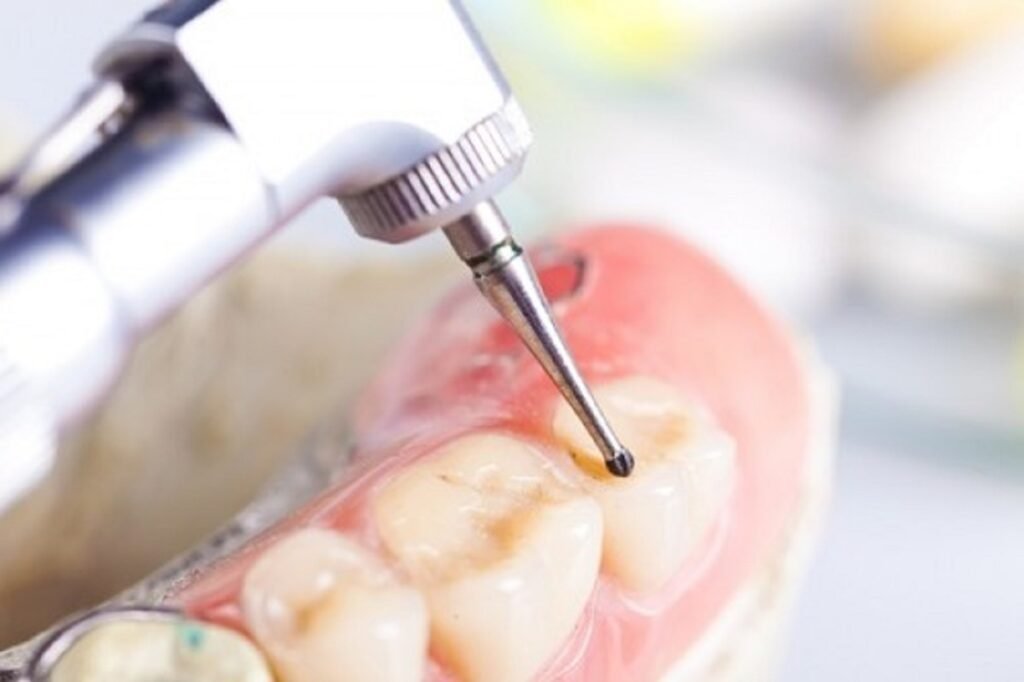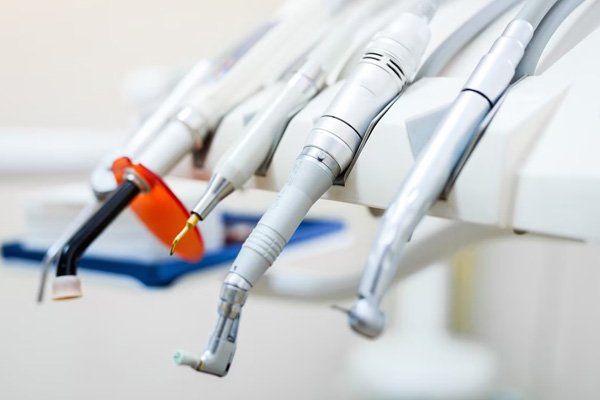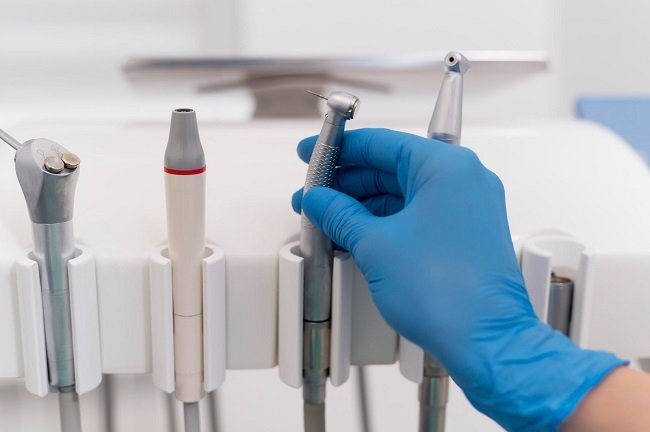Dental drills have been an essential part of modern dentistry for centuries. These instruments are essential for carrying out procedures like routine fillings to maxilled procedures like root canals and so on. In recent times, with the evolution in technology and science and the introduction of some high-end equipment, the design, operation, and accuracy of dental drills have improved and now dental practitioners can provide excellent quality work with minimal pain to the patients.

In this article, we’ll explore the different types of dental drills, their features, and their applications in dentistry. We’ll also highlight the benefits of using high-speed dental drills, electric dental drills, air-driven dental drills, and the various dental handpieces available.
What Are Dental Drills?
Dental drills are precision tools used by dentists to remove decay, shape the structure of a tooth, and prepare the tooth for various dental treatments. They are made up of a motor-driven mechanism that spins a rotating instrument at high speeds enabling the dentist to do the task with precision. The dental drill is frequently used with bur attachments, which come in many shapes and sizes for various treatments.
The evolution of dental drills has brought about numerous advancements, with the introduction of high-speed dental drills, electric dental drills, and air-driven dental drills. These modern tools help to minimize pain, increase efficiency, and provide better results for patients.

Types of Dental Drills
There are different types of dental drills for different dental procedures. Here are some of the more common dental drill types that you might find in use today.
1. High-Speed Dental Drills
- High-speed dental drills are the most commonly used drills in dentistry. These drills are typically powered by compressed air, with speeds reaching up to 400,000 RPM. High-speed dental drills also come in handy for penetrating the harder surfaces of your teeth, like enamel and dentin. They are commonly employed for cavity prep, crown preparations, and old filling removal procedures.
- First, high-speed dental drills are some of the most effective tools used in dental practices due to the precision they can achieve when removing tooth structures. This enables them to carry out procedures throughout the day at a high pace, facilitating swift chair time for patients, and overall treatment efficiency.
2. Electric Dental Drills
- Electric dental drills are powered by a small electric motor, providing more consistent power compared to air-driven dental drills. They are also handy when doing more slender processes where controlling speed, torque, and power is critical. Electric Dental Drill are generally used for dental procedures like root canals, dental implants, and orthodontics.
- Electric dental drills also produce less vibration, making them more comfortable for both patients and dentists. The reduced noise and vibration help create a more relaxing experience for patients, particularly those who may have dental anxiety.
3. Air-Driven Dental Drills
- Air-driven dental drills are powered by compressed air, which makes them lightweight and easy to maneuver. So these are utilized for lots of different dental procedures which means fillings, crowns, and impotent to mention a few. The lightweight and low-cost nature of the air-powered dental drill makes it a favorable choice amongst many dental professionals.
- Air-driven dental drills provide less power consistency – therefore maybe less accuracy in certain procedures – than electric dental drills. However, air-powered dental drills are still widely used in general dental practices.
Key Features of Dental Drills
Dental drills come with a variety of features that enhance their functionality and precision. Let’s take a closer look at some of the most important features of dental drills:
● Speed Control
Dental drills come with variable speed control, which is crucial for performing a wide range of procedures. A high-speed dental drill can reach speeds of 400 times per minute which means that these drills can penetrate through a difficult material consisting of both enamel and dentin. Slow and ultra-slow drills are usually used for softer drills, such as polishing and finishing.
● Motorized or Air-Driven
There are two main types of dental drills motorized (electric) and air-driven. Electric dental drills provide consistent power and speed, making them more efficient and easier to control. Unlike electric drills, which can be heavier and are dependent on an electrical power source, air-driven drills are powered by compressed air, which makes them lighter and thus more agile in navigating – in other words, more maneuverable.
● Ergonomic Design
Modern dental handpieces are designed to be comfortable for the dentist to hold and use for extended periods. Dental handpieces are ergonomically designed to minimize fatigue during hours of operation, focusing on precision while this process becomes smoother and less taxing.
● Cooling Systems
Dental drills are commonly designed with a cooling mechanism, usually between the drill itself or sprays of water or air, to maintain both the drill and the tooth at a lower temperature. This minimizes the risk of damaging either the drill or the tooth with excessive heat..

Dental Drill Shapes and Attachments
Dental drills are available in various shapes, which correspond to different types of dental burs used with the drill. These burs come in different shapes and sizes, the shape and size of these burs are pivotal to the work being carried out, be it cavity preparation, shaping, and polishing.
Some common dental drill shapes include:
- Round burs: Perfect for cavity preparations and decayed tissue removal.
- Fissure burrs: prepare grooves in the tooth or for crowns
- Pears burrs: for cutting inside the tooth and creating cavities
Each shape is designed to cater to specific dental tasks, ensuring precision and efficiency during dental procedures.

Advantages of Using Dental Drills
The introduction of advanced dental drills has brought numerous benefits to both dental professionals and patients. Here are the biggest benefits of using the new, modern dental drills:
● Increased Precision
High-speed dental drills, in particular, or high-precision dental drills, are the most commonly used precision signal tools, needles, and other instruments. These drills can rotate at a high speed, and work comfortably, so they make for perfect cavity preparation, tooth shaping, and decay removal.
● Faster Treatment Time
High-speed dental drills allow dentists to achieve more in less time, thus reducing chair time for patients. Less treatment time means more efficiency because dentists can increase the number of patients they treat per day which is always beneficial throughout their day.
● Improved Patient Comfort
Modern dental drills have less noise, and less vibration, and are applied with less force against the tooth than past conventional drills, causing less discomfort in patients. Electric and air flow-driven dental drills are also a lot quieter when compared with conventional models, hence will aid in easing the stress and discomfort of the patient. They also minimize the risk of thermal damage to the tooth via cooling systems.
● Versatility
Dental drills may be used for many dental procedures including cavity preparation, root canals, crowns, and orthodontic procedures. Depending on your needs, there are many different types of dental drill shapes and attachments, to which your dentist can tailor your Dental Treatments with.
Uses of Dental Drills In Dentistry
Dental drills are used in a wide range of procedures in modern dentistry. Some of the key applications include:
● Cavity Preparation
Dental drills serve mainly the purpose of getting rid of the tissue within the tooth that has decayed and cleaning the cavity to receive fillings. This method is best used with high-speed dental drills which will quickly remove decay.
● Root Canal Treatment
During root canal treatments, an electric dental drill is frequently used to gain access to the tooth pulp and eliminate infected tissue. Thanks to the exact regulation of electric dental drills, the treatment is carried out with the least possible discomfort to the patient.
● Crown and Bridge Preparation
Dental drills are employed to bald teeth to match crowns and bridges. Many types of restorations require certain contours, and high-speed dental drills allow for the best precision when working with such materials.
● Implant Placement
In the context of dental implant procedures, electric dental drills, and high-speed dentals are often utilized to prepare the jawbone in anticipation of an implant. This makes a more contained, more even hole in which to place the implant post, which means that the implant is held in place more reliably.

Why Choose Aidite Dental Drills?
The dental drills of Aidite are high precision, high reliability, and high comfort for patients. Featured with the Latest Technology these drills provide high control, low vibration, and noise to make both the dentist and patient experience comfortable. This ergonomic design minimizes tired hands and enables practitioners to perform lengthy procedures with less effort. The Aidite dental drill is no doubt a perfect solution, whether you are going to make cavities, crowns, or prepare implants — these will perform greatly, enduring times of constant usage, and will give you the same high-quality results all the time. Select Aidite for its commitment to delivering a level of care and quality that supports the best possible results with every therapy.
FAQs
Q1. What is the difference between highspeed dental drills and electric drills in dentistry?
High-speed dental drills work very fast with the help of compressed air and appropriate through hard tissue. Electric dental drills provide patients and dentists with high control with consistent speed, perfect for delicate procedures.
Q2. Are air-driven dental drills better than electric dental drills?
Electric versus Air Driven Dental Drills Electric dental drills are more powerful and also offer better precision, control, and consistent force making them highly ideal for complex procedures and minimizing discomfort for the patient. Electric dental drills weigh more than air-driven drills, are more expensive than air-driven drills
Q3. How do dental drills improve patient comfort during treatment?
Modern dental drills are especially ergonomic, so they cause way less discomfort and anxiety because they vibrate less and maintain the ideal temperature at the drilling point, which provides smoother, quieter, and more comfortable procedures for the patient.
Conclusion
Dental drills are essential tools in modern dentistry, providing precision, efficiency, and comfort for both dentists and patients. High-speed dental drills, electric dental drills, air-driven dental drills and many more you use to make sure that procedures are performed at a standard of care. Comprehending the characteristics, advantages, and styles of dental drills can significantly aid dental professionals in making the right choices that improve treatment outcomes and patient comfort. Dental technology is an ever-evolving field, but the dental drill will continue to be a main component of successful Dental Care for years to come.



